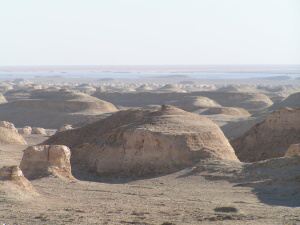
update reports pictures
report 36 report 37 report 38
home
velotour 2004-2006
contact

update
reports
pictures
report 36
report 37
report 38

|
The Qinghai- Tibet plateau is the highest and youngest plateau in the world. It developed two million years ago as a result of the collision of the Indian and Eurasian continents, which caused the earth’s crust to rise 4000 metres above sea level. Before this time the area had been a big ocean, as is confirmed by masses of fossils from the sea. Today it is a huge dry desert like area with not much vegetation, home of the Tibetan people, and famous as the "roof of the world".
We cycled 1900km east over the desolate northern part of this barren plateau at an average altitude of 3000metres from the little town of Qarkilik (Ruoqiang), in the province of Xinjiang on the southern edge of the Taklamakan desert, to Xining capital of Qinghai province. We have nowbeen cycling for more than two years but this was the most difficult part of our journey. We suffered a great deal. But despite difficulties finding adequate supplies we were fascinated by the moonlike landscape with just the blue sky to remind us that we were still on our own planet.
The preceding 1600km through the Taklamakan desert was easy in comparison, but the second break of my bicycle frame delayed the journey into Tibet for a whole month. Initially we were happy to get into the mountains again, after 1600km flat and desolate sand desert. But we underestimated the coldness and the onset of winter made our trip a torture.

|
One night we measured 19 Degrees below zero and this degree of cold brought any sense of fun to an end. On such days we needed up to 1 litre of petrol for our MSR petrol-cooker to make the situation even bearable. But necessity is the mother of invention and we learned to handle the situation. When it was extremely cold we used our four aluminium drinking water bottles as hot water bottles. We filled them with boiling water and put them into the sleeping bags. This made very good sense, because besides providing us with heat in bed the stove helped to warm the tent, and the water itself being freed of bacteria became drinkable. In two hours the reliable cooker increased the temperature by 9 degrees (still 10 below zero!). Mostly we slept in deep pits of 2-3 meters, a legacy of the road construction. This was not very romantic, but useful because
it kept off the wind. Probably without this protection we would have become just big ice bags. In such cold you don't sleep very well. We were woken often by the intelligence of the body which wouldn't let usfreeze to death. When it was extremely cold we got up in the middle of the night, about 2 am, and boiled the water anew to make tea and recharge the hot-water bottles. In the morning the bottles were good firstly to warm up the hands whilst striking camp and later as a warm drink.

|
In road construction the Chinese are world champions. A new asphalt road the G315 from Qarkilik to Xining is under construction and at one part we came to a place where we almost lost both the energy and the nerve to continue. The road passed through marshland near a big lake. Moving masses of water made the road so completely soggy that it was absolutely impossible to move here by car. A petrol tanker (big car) stood hopelessly absorbed into the morass. Compared with the cars we had a big advantage with our bicycles, though we soon found ourselves sinking up to the knees and it took more than one hour to cover 3 km as we fought our way out with our heavy bicycles.

|
The villages on our map were being by-passed by the new road and might as well as not have existed any more for all the good they were to us. Often there were no possibilities to buy food and there was no water in this barren land. We were at the mercy of the road workers who rescued us by sharing their food and their water.

|
On 29th of November 2006 we crossed our highest pass at 3800 m and were overjoyed to get out of the mountains without damage. In a little village just after the high pass, near "Qinghai Hu" the biggest lake in China and a holy place for the Tibetan people, we met the cycling sculpture artist Louren from Shanghai going in the opposite direction. Thoroughly convinced of his plans he showed us his "Alaska” coat, fur-lined shoes and a big suitcase full of medicine. We felt frozen whenever we thought about his plans and moved to warmer areas as quickly as possible. From then on the road was all downhill. After 200 km of easier riding we reached the large town of Xining at just 2200 m. andreaslina@yahoo.de